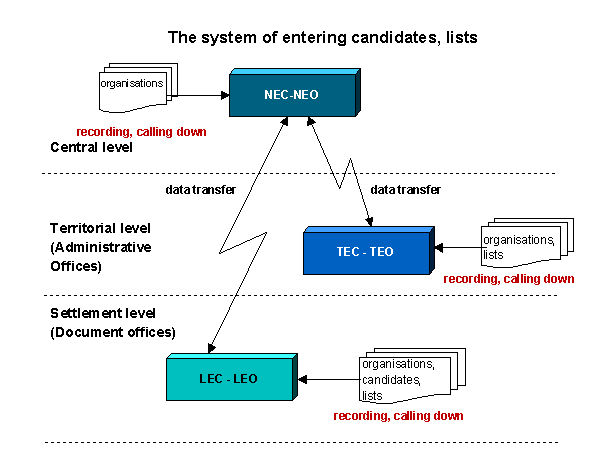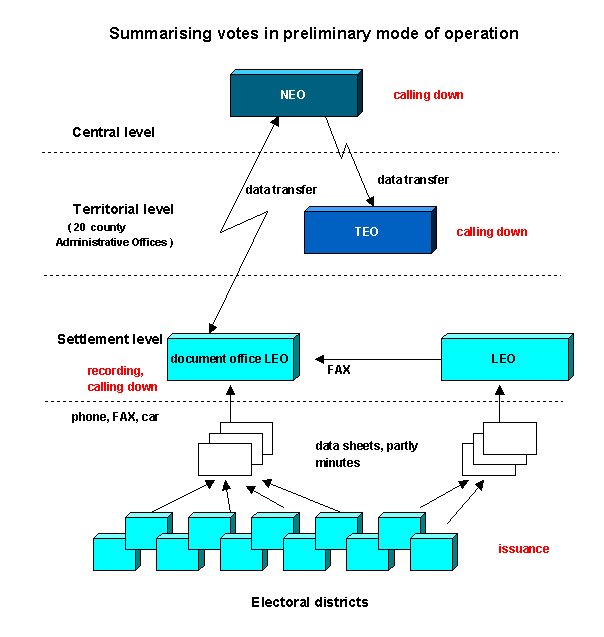
VII. COMPUTERISED DATA PROCESSING SYSTEMS
The local elections of 2002 are conducted on a document office infrastructure which worked well when used first during the parliamentary elections.
When developing the systems the aim is, by making use of the experience gained both during the elections in 1998 and the parliamentary elections in 2002, to establish integrated solutions based on a common and uniform database realised on central level.
The information technology systems of the elections cover the entire election process from making the register to ascertaining the final results.
The use of document network and the integrated development of applications ensure that the aims set can be
achieved:
- continuous operation with zero fault,
- supporting that the elections results are ascertained quickly and authentically,
- ensuring the cleanness and enforcing the basic principles of the elections,
- continuously providing election bodies, political parties, nominating organisations, the media and voters with information.
In the following, the most important functions of the key IT systems supporting the elections will be described. In addition to the systems to be specified, several other minor systems are operated to ensure that information, management and other special requirements are met such as the program supporting system of public service televisions, the elections history database, the production of publications, the financial information system, and the internal management system (Figure 1).
VII.1. The system for setting up constituencies, generating and maintaining the voter register and handling the registration of those not having right of vote
The system is able to receive and hand over data stocks of districts on the county database of the upgraded population registration system. It handles the stock of those not having right of vote received from the central system.
The program system allows that registers and information notices are printed in a centralised and decentralised (local government printing option) operation mode.
The system is equipped for meeting claims for providing political parties, the election bodies and other persons entitled to demand such services with data of statistical nature.
VII.2. The system for checking the process of proposing candidates
The process of proposing candidates is checked with the method used during this year’s parliamentary elections, with the only difference that local proposals can be checked also locally, provided that this is required by individual local election offices.
The system checking the process of proposing candidates will be able to record the proposal coupons submitted by the candidates, and check them with a computer supported method, this will take place at the mayor’s office of the document office seat settlements, by using the database installed at the county Administrative Offices. For checking data the proper register stock and the particulars of those not having right of vote are used.
The system provides the checklists and statistics required for the election committees to make decisions.
VII.3. The system for preparing the elections and the system supporting the sending and receiving of data to and from the printing house
The system allows that candidates, lists entered for the elections (settlement small list, single mandate constituency, compensation list, mayoral, and county convention, minority municipality nominations; regarding Budapest, single mandate constituency, metropolitan district compensation list, mayoral, metropolitan list, Mayoral, minority municipality, minority compensation list nominations) are recorded, placed on file by feeding data into the computer locally, regionally or centrally.
In addition to feeding data, the system ensures that data having been recorded can be searched, displayed, listed and, if necessary, modified in a certified form.
The system monitors the call for the election of local governments for minorities and actions taken to prepare the process of conducting the elections.
After the process of proposing candidates has been closed, the system is able to electronically deliver the data necessary for producing ballot papers in an accurate, secure system to the printing houses. The system supplies quantity data to the entrepreneur(s) fulfilling logistics tasks and providing accessory materials in a form previously agreed upon.
It is an important element of the system that it produces electoral district identifiers, samples of minutes.
The system is able to send data to the budgetary-logistics system in a form previously agreed upon.
The system supplies data to substantiate the database for summarising votes (Figure 2).
VII.4. The preliminary vote summarising system
Considering its main aspects, the preliminary vote summarising system follows the architecture applied during the parliamentary elections. It means that in respect of the document office seat settlements all the processing is implemented by the central application. Hereby, from these settlements data specified on the level of electoral districts (data sheets and/or minutes) will be automatically sent to the central database as early as in the preliminary vote summarising process. This covers approx. 60% of the electoral districts. Subsequently, in terms of the professional aspects of the elections, any kind of elections of the capital (of the Mayor, the metropolitan convention, district mayors, district councils and district minority municipalities), the election of local governments of settlements with more than 10,000 inhabitants, and the election of local governments of larger settlements with less than 10,000 inhabitants will be solved. Regarding the size of settlements it means that the vote summarising process of every settlement with six electoral districts or larger than that, and a part of settlements with five electoral districts is implemented on-line.
The feeding of data sheets and minutes into the computer is performed, in order to avoid possible recording mistakes, by numerical checking and collating in the course of the preliminary vote summarising process, and by double feeding when ascertaining the final results.
The vote summarising process builds up its own database setting out from the data of the Election Preparing System.
The system to be realised allows that turnover data are recorded, the data received are aggregated, and that national and regional turnover data are supplied through the information system. The system supports the reporting of extraordinary events.
The most important function of the election day system is the preliminary vote summarisingprocess. After the ballot-boxes have been closed, the process of summarising votes commences. If controversial ballots are found while counting the ballots, then to ensure swift aggregation of results, data sheets are made out, pursuant to the provisions set forth under the decree of the Ministry of the Interior, on which controversial ballots may also be indicated. If there are no controversial ballots, then the minutes are drawn up straight. The completed and checked data sheets and minutes will be forwarded either via fax, telephone or by car to the nearest document office or a mayor’s office operating a local summarising system where their data are recorded by using the system. The data will be sent through the network to the central database where the system continuously performs the calculation of preliminary results while simultaneously indicating the relevant extent data have already been processed and taking controversial ballots into consideration.
The system provides transfer of data to the information system and the TV program supporting system. While continuously calculating preliminary “fast” results, the election day system supplies the information system with current data in every 10 minutes.
The system provides handling of electoral districts out of order. During the elections it might occur that the operation of some electoral districts is hindered by external factors (e.g., bomb hoax). In such cases, this change has to be carried over in the records, furthermore, the system has to make out a report addressed to the election bodies on the fact that the given electoral district has fallen out. The maintenance of the records is of paramount importance in terms of the possibility to implement the checking of entirety too.
After closing, the basic task of the system is to supply proper data for the NEO report to be included in the express information publication to be made out in one plus four languages to be issued on the day following the election day (Figure 3).
VII.5. Information systems
The task of the information system is to safely implement that, while preparing and conducting the elections, the professional machinery of the elections, the public, the political parties and the media are provided with information extensively. When displaying information, the key aspect is speed and intelligibility but aesthetic and formal elements are also taken care of. From the system, not only simple data (results minutes) but also pre-programmed analyses and comparative analyses comparing data to those of previous elections can be called down.
We shall provide Internet/intranet information regarding both the preparatory process of the elections and the process of ascertaining the results in the form used at and already known from the parliamentary elections.
The Internet systems provide data regarding each type of elections on the level of results minutes (not of electoral districts). The data of all of the minutes of the entire election, including electoral district minutes, will be entered into the election history database, and, will be available for inquirers on “Party-CD” a few days after the elections. Also, the information systems supply data to be displayed in the TELETEXT
system.
VII.6. The final vote summarising system
The final vote summarising process will last from closing the preliminary vote summarising process to producing the final and absolute results. Its function is primarily to support the election offices’ activity to ascertain the results.
At this stage, nothing else but the electoral district and the results minutes, and the data of the events of redress concerning the minutes already processed will be processed. The minutes can be entered into the system at the point of processing of the election committee issuing them, the data of redress proceedings at the point of processing of the election committee having made the decision.
After closing the legal redress proceedings, the CD containing the final and absolute election results data will be produced from the final and absolute results.
The NEC report will be made out and the data will be fed into the Election History Database.
The logistic structure of the system is shown in Figure 4.
VII.7. The system signalling the probability of electoral delicts
The system is produced by adapting the statistical analysing methods applied at the parliamentary elections of 2002 to the local governmental and minority elections.
The programs provide the recording of the data of the citizens voting with a certificate and the data of the issuance of such certificates. By checking and comparing the recorded data it will be possible to reveal delicts possibly committed.
The system helps to find cases where abuse is suspected by examining the vote summarising database according to several aspects with regard to both the preliminary and the final results. After the data thus generated have been analysed, the competent election bodies may take necessary
actions.
The Election Systems

Figure
1: Large-scale connections of election systems

Figure 2: The
logistic structure of the system of entering candidates, lists

Figure 3: The logistic structure of the election day system

Figure
4: The logistic structure of the system to ascertain the final legal results